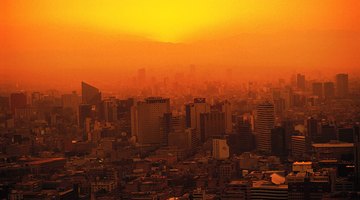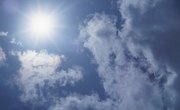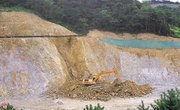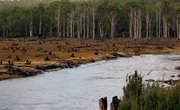In the classical sense, smog equals smoke plus fog, but for the people who live in sun-drenched basins, such as Los Angeles, the equation is a little more complicated. Classical smog is primarily the product of coal-fueled fires from factories and is also known as industrial smog. The smog common in Los Angeles comes from automobile and other fossil-fuel emissions; since the energy of the Sun makes it noxious, it's known as photochemical smog.
Climatic Factors
While both industrial and photochemical smog require an atmospheric inversion layer to push them to the ground, they occur under different climatic conditions. Industrial smog occurs in foggy, cool weather typical of that experienced in the British Isles and the eastern seaboard of the United States. Photochemical smog, on the other hand, occurs in hot, dry climates, and particularly on sunny days. Cities noted for this type of smog, such as Los Angeles, Tokyo and Mexico City, are typically surrounded by mountains that prevent air circulation. While industrial smog is most intense in the early morning, photochemical smog peaks at midday.
Differences in Composition
Industrial smog contains two primary components: sulfur dioxide and particulate matter. These combine with the water in fog to produce acidic precipitation -- sulfur dioxide dissolves in water to form sulfuric acid -- and thick, tar-laden droplets. The primary pollutant in photochemical smog, on the other hand, is ozone. It is produced when nitrogen oxides and volatile organic compounds in automobile and fossil-fueled power-plant emissions combine with oxygen in the air in direct sunlight. Whereas industrial smog casts a gray pallor over the areas it affects, the nitrogen dioxide in photochemical smog creates a dingy, brownish haze.
Health Hazards
Both industrial and photochemical smog can kill. Ozone damages lung tissue and can lead to decreased resistance to infectious diseases, and the VOCs and nitrogen oxides in photochemical smog can also lead to chronic lung damage. California state officials estimate that 9,000 people die annually in that state from smog-related causes. The effects of industrial smog are more immediate. Smog fatalities that occurred in London through the 1800s and early 1900s -- as well as during the Great Smog of 1952 -- typically occurred while the smog was in the air or a matter of weeks thereafter.
Secondary Pollutants
The primary by-product of industrial smog is acid rain, which results from the combination of sulfur dioxide and water. Moreover, tar and particulate matter settle on surfaces throughout the affected area. Photochemical smog, on the other hand, produces a host of secondary pollutants that result from a series of complex chemical reactions. Ozone is the most important of these, but carbon monoxide and peroxyacetyl nitrates (PAN) are two others -- they result from reactions involving hydrocarbons and nitrogen oxides, which are both primary by-products of fossil fuel combustion. Carbon monoxide leaches oxygen from the bloodstream, and PAN is an eye irritant.
Related Articles
References
Resources
Writer Bio
Chris Deziel has a bachelor's degree in physics and a master's degree in humanities. Besides having an abiding interest in popular science, Deziel has been active in the building and home design trades since 1975. As a landscape builder, he helped establish two gardening companies.











